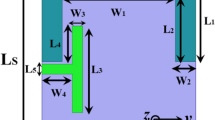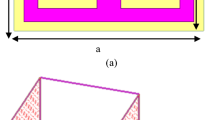Abstract
In this paper, we present the radiated mode indoor radio coverage performance study of a co-existing dual technology, dual 4×4 Multiple Input Multiple Output (MIMO) antenna platform. The antenna platform is targeted to be used for low power wireless radio Base Station (BS) applications. One of the 4×4 MIMO antenna pairs operates in the 2.5–2.7 GHz licensed Long Term Evolution (LTE) band while the other MIMO antenna pair operates in the 2.4 GHz unlicensed Wireless Fidelity (Wi-Fi) Industrial Scientific Medical (ISM) band. This radio performance study is carried out to analyze, predict and verify the impact of multi-radio co-existence on the radiated mode indoor coverage performance in an Over-The-Air (OTA) scenario. The study involves OTA radio propagation modeling, prediction and verification both for a near field and far field scenario. While the near field coverage is studied in a small form factor controlled shield box environment, the far field coverage study is undertaken over a 780 ft2 indoor enterprise coverage area. The test result shows the worst case LTE signal level is –77.7, –75, and –76.03 dBm, respectively, over a 3.6 m obstructed radial Line Of Sight (LOS) distance.







Similar content being viewed by others
REFERENCES
Y. Cao, E.J. Sunde, K. Chen, “Multiplying channel capacity: Aggregation of fragmented spectral resources,” IEEE Microwave Mag. 20, No. 1, 70 (2019). DOI: https://doi.org/10.1109/mmm.2018.2875631.
2. Ye, Y.; Wu, D.; Shu, Z.; Qian, Y. “Overview of LTE spectrum sharing technologies,” IEEE Access 4, 8105 (2016). DOI: https://doi.org/10.1109/access.2016.2626719.
Digital cellular telecommunications system (Phase 2+); Universal Mobile Telecommunications System (UMTS); LTE; E-UTRA, UTRA and GSM/EDGE; Multi-Standard Radio (MSR) Base Station (BS) conformance testing (3GPP TS 37.141 version 11.2.1 Release 11) (ETSI, 2012-10).
LTE; Evolved Universal Terrestrial Radio Access (E-UTRA); Base Station (BS) conformance testing (3GPP TS 36.141 version 9.11.0 Release 9, ETSI TS 136 141 V9.11.0 (2012-10).
LTE; Evolved Universal Terrestrial Radio Access (E-UTRA); Base Station (BS) conformance testing (3GPP TS 36.141 version 10.1.0 Release 10), ETSI TS 136 141 V10.1.0 (2011-01).
802.11n-2009 - IEEE Standard for Information technology—Local and metropolitan area networks— Specific requirements— Part 11: Wireless LAN Medium Access Control (MAC)and Physical Layer (PHY) Specifications Amendment 5: Enhancements for Higher Throughput, C/LM - LAN/MAN Standards Committee (2009). DOI: https://doi.org/10.1109/ieeestd.2009.5307322.
M. H. Ng, S.-D. Lin, J. Li, S. Tatesh, “Coexistence studies for 3GPP LTE with other mobile systems,” IEEE Commun. Mag. 47, No. 4, 60 (2009). DOI: https://doi.org/10.1109/mcom.2009.4907408.
E. Kotobelli, R. Kushe, “Wi-Fi behavior in presence of UMTS for indoor environment,” Proc. of IEEE Int. Conf. on Network-Based Information Systems, 7-9 Sept. 2011, Tirana, Albania (IEEE, 2011), pp. 502-506. DOI: https://doi.org/10.1109/nbis.2011.82.
A. Farshad, M. K. Marina, F. Garcia, “Experimental investigation of coexistence interference on multi-radio 802.11 platforms,” Proc. of 10th Int. Symp. on Modeling and Optimization in Mobile, Ad Hoc and Wireless Networks, WiOpt, 14-18 May 2012, Paderborn, Germany (IEEE, 2012), pp. 293-298. URI: https://ieeexplore.ieee.org/document/6260470
Z. Hu, R. Susitaival, Z. Chen, I-Kang Fu, P. Dayal, S. K. Baghel, “Interference avoidance for in-device coexistence in 3GPP LTE-advanced: challenges and solutions,” IEEE Commun. Mag. 50, No. 11, 60 (2012). DOI: https://doi.org/10.1109/mcom.2012.6353683.
Z. Zheng, J. Wang, X. Peng, C. Zhao, “Coexistence analysis between WCDMA and TD-LTE systems in multimode terminals,” Proc. of IEEE Int. Conf. on Computational Intelligence and Communication Networks, 14-16 Nov. 2014, Bhopal, India (IEEE, 2014), pp. 295-299. DOI: https://doi.org/10.1109/cicn.2014.73.
S. V. Zaitsev, V. V. Kazymyr, “Method for adaptive decoding in case of information transmission in condition of influence of deliberate noise,” Radioelectron. Commun. Syst. 58, No. 5, 212 (2015). DOI: https://doi.org/10.3103/s0735272715050039.
S. Sagari, I. Seskar, D. Raychaudhuri, “Modeling the coexistence of LTE and WiFi heterogeneous networks in dense deployment scenarios,” Proc. of IEEE Int. Conf. Communication Workshop, ICCW, 8-12 Jun. 2015, London, UK (IEEE, 2015), pp. 10367–10372. DOI: https://doi.org/10.1109/iccw.2015.7247524.
Enterprise multi-Femtocell Deployment Guidelines (Qualcomm Inc., 2011).
D. Micheli, M. Barazzetta, C. Carlini, Riccardo Diamanti, V. M. Primiani, F. Moglie, “Testing of the carrier aggregation mode for a live LTE base station in reverberation chamber,” IEEE Trans. Vehicular Technology 66, No. 4, 3024 (2016). DOI: https://doi.org/10.1109/tvt.2016.2587662.
Z. Zhou, F. Teng, J. Liu, W. Xiao, “Performance evaluation for coexistence of LTE and WiFi,” Proc. of Int. Conf. on Computing, Networking and Communications, ICNC, 15-18 Feb. 2016, Kauai, USA (IEEE, 2016), pp. 1-6. DOI: https://doi.org/10.1109/iccnc.2016.7440570.
S. R. Saunders, A. Aragon-Zavala, Antennas and Propagation for Wireless Communication Systems, 2nd ed. (John Wiley and Sons, 2007). URI: https://www.wiley.com/en-us/Antennas+and+Propagation+for+Wireless+Communication+Systems%2C+2nd+Edition-p-9780470848791.
T. K. Sarkar, Z. Ji, K. Kim, A. Medouri, M. Salazar-Palma, “A survey of various propagation models for mobile communication,” IEEE Antennas Propag. Mag. 45, No. 3, 51 (2003). DOI: https://doi.org/10.1109/map.2003.1232163.
A. Hrovat, G. Kandus, T. Javornik, “A survey of radio propagation modeling for tunnels,” IEEE Commun. Surveys Tutorials 16, No. 2, 658 (2014). DOI: https://doi.org/10.1109/surv.2013.091213.00175.
G. Castro, R. Feick, M. Rodriguez, R. Valenzuela, D. Chizhik, “Outdoor-to-indoor empirical path loss models: analysis for pico and femto cells in street canyons,” IEEE Wireless Commun. Lett. 6, No. 4, 542 (2017). DOI: https://doi.org/10.1109/lwc.2017.2715169.
V. Degli-Esposti, J. S. Lu, J. N. Wu, J. J. Zhu, J. A. Blaha, E. M. Vitucci, F. Fuschini, M. Barbiroli, “A semi-deterministic method for predicting indoor cellular coverage in dense urban areas,” Proc. of 10th European Conf. on Antennas and Propagation, EuCAP, 10-15 Apr. 2016, Davos, Switzerland (IEEE, 2016), pp. 1-3. DOI: https://doi.org/10.1109/eucap.2016.7481845.
W. Fan, I. Carton, P. Kyosti, G. F. Pedersen, “Emulating ray-tracing channels in multiprobe anechoic chamber setups for virtual drive testing,” IEEE Trans. Antennas Propag. 64, No. 2, 730 (2016). DOI: https://doi.org/10.1109/tap.2015.2498951.
X. Wu, Z. Liu, Z. Zhang, C.-H. Liao, Z. Quan, “MIMO OTA testing on WiFi devices and 3D channel modeling in multi-probe anechoic chamber systems,” Proc. of Progress In Electromagnetic Research Symp., PIERS, 8-11 Aug. 2016, Shanghai, China (IEEE, 2016), pp. 4275-4281. DOI: https://doi.org/10.1109/piers.2016.7735601.
M. B. El Mashade, B. M. El Saghir, “Performance characterization of MIMO channels with hybrid diversity,” Radioelectron. Commun. Syst. 62, No. 6, 286 (2019). DOI: https://doi.org/10.3103/s0735272719060049.
iBwave, Indoor propagation modeling SW Tool (2016).
Rec. ITU-R P.1238-1. Propagation Data and Prediction Methods for the Planning of Indoor Radio Communication Systems and Radio Local Area Networks in the Frequency Range 900MHz to 100GHz, International Telecommunication Union (1997–1999).
Rep. ITU-R M.2134. Requirements related to technical performance for IMT-Advanced radio interface(s), International Telecommunication Union (2008).
Rep. ITU-R M.2135. Guidelines for evaluation of radio interface technologies for IMT-Advanced, International Telecommunication Union (2008).
V. Degli-Esposti, E. M. Vitucci, R. Martin, “A simple and versatile field prediction model for indoor and indoor-to-outdoor propagation,” IEEE Access 5, 13270 (2017). DOI: https://doi.org/10.1109/access.2017.2715119.
Author information
Authors and Affiliations
Corresponding author
Ethics declarations
ADDITIONAL INFORMATION
Saroj K. Patro, Rabindra K. Mishra, and A. K. Panda
The authors declare that they have no conflict of interest.
The initial version of this paper in Russian is published in the journal “Izvestiya Vysshikh Uchebnykh Zavedenii. Radioelektronika,” ISSN 2307-6011 (Online), ISSN 0021-3470 (Print) on the link http://radio.kpi.ua/article/view/S0021347020020028 with DOI: https://doi.org/10.20535/S0021347020020028
About this article
Cite this article
Patro, S.K.P., Mishra, R.K. & Panda, A.K. Study of Indoor Radio Coverage Performance of Dual Technology Co-Existing MIMO Antenna Platform for Low Power Wireless Base Station. Radioelectron.Commun.Syst. 63, 66–76 (2020). https://doi.org/10.3103/S0735272720020028
Received:
Revised:
Accepted:
Published:
Issue Date:
DOI: https://doi.org/10.3103/S0735272720020028




